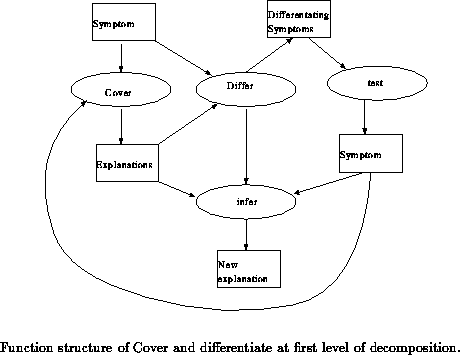

 Previous: Domain knowledge Up: Cover & differentiate Next: Modelling operations
Previous: Domain knowledge Up: Cover & differentiate Next: Modelling operations
Task knowledge
C&D combines and rules-out explanatory relations. The relations are
indexed by symptoms they explain and constraints they introduce. C&D
searches for a covering set of explanations by dividing the task into a
covering step and a differentiate step. Cover takes a set of features
(symptoms) and produces a set of theories (explanations) that seem
applicable; differentiate tries to rule out elements of this set. The
cover and the differentiate sub-tasks are not equally complex; the domain
schemata support the cover task by a cover domain operation. Cover can
therefore also be classified as a `primitive-inference-action' (PIA). The
differentiate task is not directly supported by the domain ontology.
It is therefore necessary to decompose this task.
(PIA). The
differentiate task is not directly supported by the domain ontology.
It is therefore necessary to decompose this task.
- cover-task(+Symptom, -Explanation*)
There is a binary relation R(symptom, explanation) in the domain schema, S
is a set of symptoms, E is a set of events. The goal of task cover
is to create an explanation E for which holds: for each of the elements s
of S and for each of the elements e of E, R(s, e) holds.
- differentiate-task(+Symptom*, +Explanation*, -New-symptom*,
-Refined-Explanation*)
Differentiate is a task that takes a set S (the Symptoms),
a set E (the original Explanations), and creates a set N (New
symptoms), and a set F(the Refined Explanations).
The goal of Differentiate-task (S, E, R, F) is to create a set N of New
symptoms and a set NE of new explanations for which holds:
0pt
- sep 0pt
- cover(S, E) holds.
- cover(F, E) holds.
- E a subset is of F.
- If the result of the observation request is positive then should F
cover N too.
- If the result of the observation request is negative then R may not
be part of either the required symptoms or the enabling symptom of an
element of F.
Function structures can be defined at each level of task decomposition.
Figure  shows a function structure at the first level of
decomposition.
shows a function structure at the first level of
decomposition.


Sub-tasks of differentiate are:
- differ-task(+E:explanation*, +IS:symptom*, -R:request*). This
task takes the explanations and searches for a set of
differentiating symptoms. These symptoms are then requested to the
test task. There are four different ways to do this;
- By directly testable competing events. Some events are directly
observable and can be passed directly as a request to the test
sub-task.
- By finding symptoms that rule out competing events. Different
events have always some non-overlapping symptoms, testing these rule
out at least one of the competing events.
- By finding symptoms that form an enabling connection. Some
competing events have associated enabling events. If the enabling
events cannot be observed, then the competing event cannot be used
in the explanation.
- By using required symptoms of competing events. If the required
event is not available then the competing event cannot be an
explanation.
- test-task(+R:request, -S:symptom). The test task checks whether a
requested symptom is available.
- infer-task(+E:explanation*, +Os:symptom*, +Ns:symptom*, -NE:explanation).
The infer task takes the set of competing explanations, the original
symptoms, the new symptom requested by the differ task and checked by
the test task. Using this information infer tries to eliminate
competing explanations and produces a new list of explanations (NE).
There are different ways to do this:
- If the requested symptom was not available and is as an `testable
event' part of the competing events, then this competing event can be
eliminated.
- If a competing event does not cover the new symptom, then this
event can be eliminated.
- If the requested symptom was not available then the events
that have this symptom as enabling connection can be removed.
- If the requested symptom was not available then the events that
have this symptom as required symptom can be eliminated.
Figure  shows a function structure of C&D at a first
level of decomposition.
shows a function structure of C&D at a first
level of decomposition.
Previous: Domain knowledge Up: Cover & differentiate Next: Modelling operations
(PIA). The
differentiate task is not directly supported by the domain ontology.
It is therefore necessary to decompose this task.
shows a function structure at the first level of
decomposition.
shows a function structure of C&D at a first
level of decomposition.